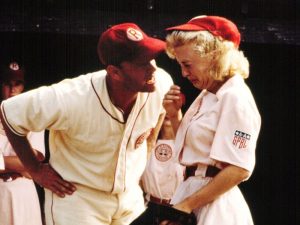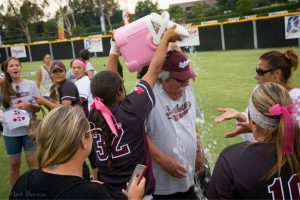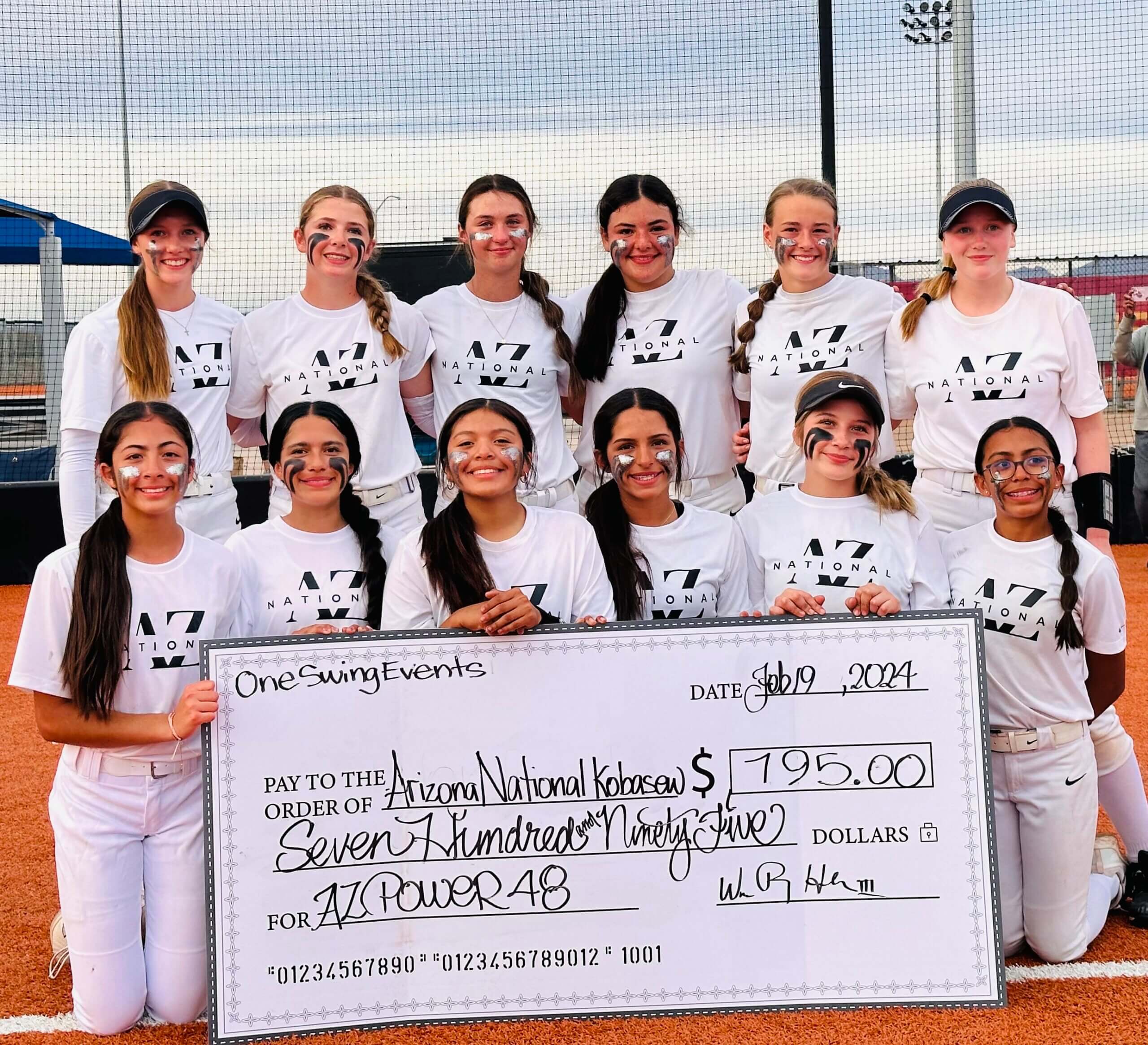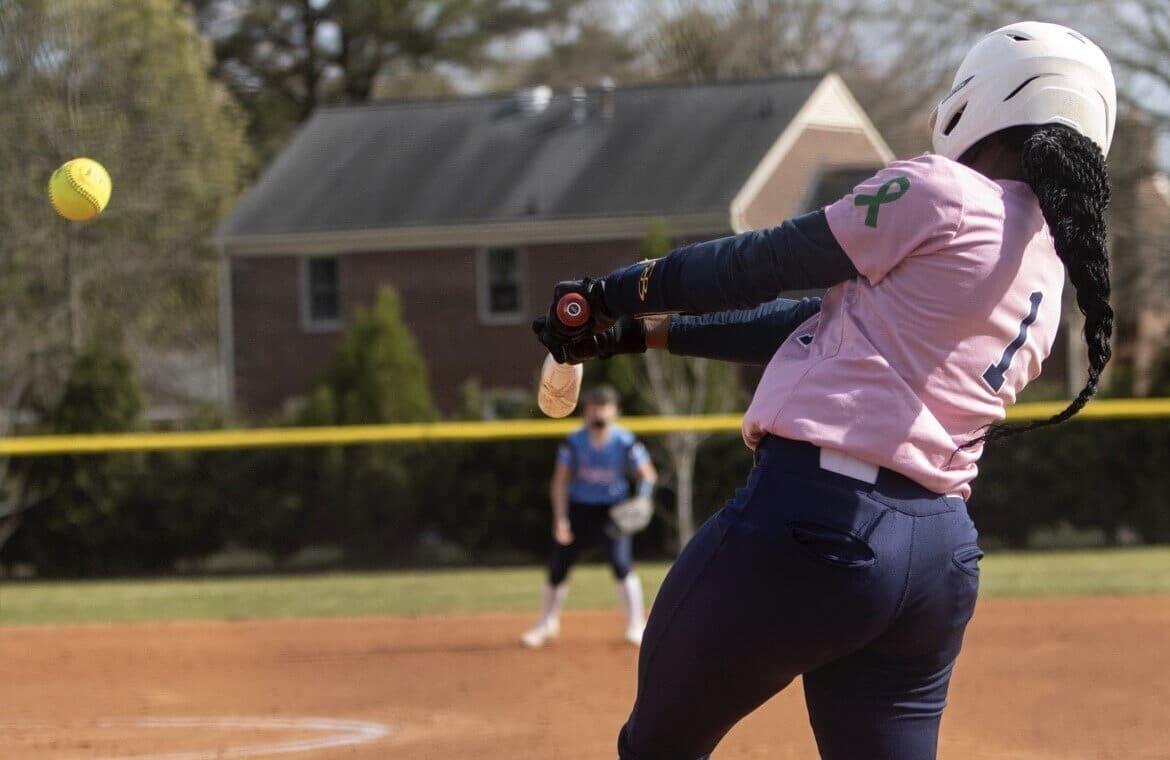
In December, legendary club coach Gary Haning was inducted into the National Fastpitch Coaches Association (NFCA) Hall of Fame at the organization’s annual convention in Las Vegas.
As described in the official release published by the NFCA, “Haning helped build the Batbusters into one of the most well-known and successful travel ball organizations in the nation, with more than 30 national championships.”
“His team rosters have been a who’s who of the top names in softball. Four-time All-American and four-time Olympic medalist Laura Berg and her twin sister Randi, delivered the Batbusters’ first 18-and-under national title in 1992 on a loaded team that also featured former UCLA standouts Nicole (Odom) Reis and Leah Poulson, former Arizona stars Leah Braatz and Andrea Doty, and Cal-Berkeley star Gillian Boxx.”
“Fellow Olympic star and Women’s College World Series champion Jennie Finch, won a 1997 national crown and had 1998 runner-up finish with the Batbusters as a teammate of her future University of Arizona teammate Toni Mascarenas.

Haning also co-founded the hugely-successful Premier Girls Fastpitch with Dan Hay.”
The coach is also a talented writer who, with over three decades as a fastpitch coach, isn’t afraid to share his opinions on issues impacting the game.
Here, he paints a vivid picture of what he believes is the good and bad regarding young pitchers today—first, humorously taking the perspective of a young fictional pitcher and then giving his thoughts on where the art of pitching is today.
Sit back and enjoy a fun and insightful read from one of the most successful coaches in fastpitch softball history and, so far, the only club ever inducted into the NFCA Hall of Fame…
***
PART ONE:
(in case this is not overly obviously, the account you’re about to read is, well… somewhat exaggerated for effect):
This is an open letter to the fastpitch softball community. My name is Starr Slinger and I have been chosen by the National Fastpitch Pitcher’s Union to address some stereotypes we feel are unfair.
The first of these malformed opinions is that we, as a group, are little princesses who need to be treated differently and have quirky personalities. This so unfair, just last week I pitched a whole weekend without my favorite hair-ribbon, I had to have my nails redone twice and my coach snagged my phone in the middle of a very important text to my friend who was on the opposing team. Did I let these catastrophes affect me? No! I went right about my business and I only cried for an hour each day.

Because many who see this are not and have never been pitchers, let me share with you some of the obstacles we must overcome.
Before I started pitching I had a very normal, loving family situation. My parents, brother and I did many things together and we had a lot of fun. Now my Dad starts shaking and runs for cover any time I walk toward him with a softball glove on my hand and I feel so bad.
The doctor says Dad will recover from the multiple hematomas on his legs and after all, he wanted me to learn that turn-over drop. There was also some issue I did not quite understand when he said, in great pain, “I guess you won’t be having any more brothers or sisters.”
Fortunately, there are dental implants now—I told my brother the pitch was going to rise but I guess he didn’t believe me. Now he hates me because his girlfriend dumped him and then she posted a snapchat showing his three missing teeth and the huge bump on his forehead.
My Mom’s former best-friend lives next door and I am so sorry, but it isn’t my fault the lady’s now dead cat was sitting in front of that window, I lost my iPad for a week on that one.
I love my dog and he loved me, past tense; I really thought the wall of his dog house was strong enough for me to throw into it, I mean I have no one left to pitch to, the Vet is going to try and save the leg and what the heck, the dog has three other good legs. I am sad that he now hobbles away and tries to dig a hole with one leg whenever I go into the back yard.
Apart from family issues we have coach issues. My coaches are good people who wish the best for me and try to help. I hope they will learn that is not helpful to sit on their bucket and say, “throw strikes.”
What exactly do they think I am trying to do? You try to put a ball in a three-inch window while pitching from a pitching rubber with a hole in front of it that could hide a small elephant and another where your stride foot lands that resembles the crater from the asteroid that killed the dinosaurs.
Not to mention that you have a person behind the plate judging your pitches who is angry because they can’t see well enough to drive to the park and whose dog led them to the wrong field and they didn’t have time to eat lunch.
When you throw a strike and it gets hit, then it’s, “No, throw a good strike;’ kinda tough to win. Finally, the coach gives a sign, you throw exactly what pitch was asked for and exactly where it was supposed to be, it gets hit, and the coach throws up his arms as if he called for something else… you know, he knows, but the fans think you blew it.
Our personal safety is always at risk and for that we may seem a little loopy. After throwing a pitch we are maybe 35 feet away from a hitter, less from a slap-hitter. Slap-hitters usually start a game and things have changed to where most of them can also swing and hit.
We start with a blazing fast athlete who may bunt, may slap, or may cream the ball right at us. If we survive a couple of those we now face two or three very strong sluggers, who hold in their hands a piece of composite alloys and plastics that is used on jet fighters and spacecraft, all the while their coach is screaming, “Hit it up the middle or hit it back at her.”
After a while, you would be a little loopy too. We have to cover bases while on the run we have to cover the plate if there is a passed ball and we don’t have body armor.
Finally, comes your teammates. I love my teammates and I realize they have saved my behind many times. If there is an error I try to encourage the culprit and assure her all is well and we will get out of trouble.
It is sometimes hard when I am pitching a good game and my outfielders are chasing butterflies or counting blades of grass instead of catching fly balls or an infielder forgets that the game where you kick the ball is not softball and that after kicking the ball it is not a good thing to do a pickup and throw for distance.
Anyway, thanks for reading this and we hope it will help all of us sisters of the circle be better understood.
Aside to coaches, no, it is not a union policy to walk the leadoff hitter in the last inning of a close game or walk the opponent’s weakest hitter to get to its best hitter but it sure is fun to watch you squirm on your bucket.
Sincerely,
Starr Sling
*****
PART TWO:
I am sure you all realize that the above is satirical and written in fun. I have been lucky to know many great pitchers who were the hardest workers on the team and are responsible for much of the success our teams had on the field and how we were perceived off the field.

I believe softball/baseball pitching to be the hardest position one can play in a team sport.
There is in my opinion and in the opinion of many long-time coaches, a real dearth of quality pitching in Southern California and across the country.
I do not mean to insult and to be sure there a number of very talented, successful pitchers but the numbers are far fewer than say 10 and certainly 15 years ago.
There are a number of reasons this has come about and I believe it could be changed.
Emphasis on More Pitches
There is far too much emphasis on throwing a variety of pitches in the younger age groups. I have been blessed to see or coach and coach against some of the best pitchers in the world for all time.
NONE of them had or has complete command of more than four pitches, only one or two had complete command of four pitches and only a small handful had complete command of three pitches.
Yet time and time again I hear a young pitcher, sometimes as young as 12, state that she can throw five or six pitches; this is total baloney or bologna, however you want to say the word.
Bring Back the Well-Placed Heater
The notion that a fastball is not used in fastpitch softball is just nuts, a well-located fastball not only can get hitters out, it is extremely effective in setting up other pitches.

Lisa Dodd won back to back 18U Gold National Championships at a time when the Gold Nationals was by FAR the top youth tournament in the U.S. and almost assuredly the world.
Lisa threw a 60 mph fastball if she had a stiff wind at her back, a 54 mph drop and a 44 MPH change-up. She gave up one unearned run in winning nine games in the two nationals.
She threw a perfect game followed by a one-hitter on a bunt single in the final games the first year and threw shutouts the final games the second year. Her greatest talent was simply that she NEVER missed a pitch. You literally could have caught for her with a blindfold and every pitch would have hit your glove.
The 3 Elements to Being a Great Pitcher Are…
Location and movement and deception are the most important factors in being a great pitcher, even if you throw 75 mph and throw the ball in the middle of the plate, waist high, it will get hit.
If a pitcher practices say four times a week at 100 pitches at a time and she is practicing four pitches, it is only reasonable to say none of those pitches is getting enough practice. Along with the fact that people tend to practice what they do well more than what they don’t do well, this is obviously backwards but it is the truth.
If you cannot throw a pitch and hit a spot very nearly every time you try, how are you then going to throw a different pitch that is a variation of the first pitch, requiring subtle changes to your mechanics and get the second pitch where you want it to go?
Before you worry too much about making the ball move, maybe it would be good to make sure you can throw it where you want to throw it!
Learn to throw strikes, where you want them, when you want them. Once you have mastered that it is a pretty easy addition to hold the ball a little off-center, turn your wrist a little in either direction and put some movement on the ball in a manner you can command.
Learn These Two Pitches for Great Success!
Unless you are 6-foot-8 and have hands the size of a gorilla, the most effective and devastating pitch in softball is the flip change-up.
It is also probably the hardest to truly command as the release is completely backward and opposite of everything else you throw. It can be mastered as many pitchers have shown but too often ego and perception get in the way.
Who wants to be known as a “change-up pitcher” at 12 or 13 years old. Unfortunately, not many and therefore it is not given the immense amount of practice time it needs to be thrown consistently.
A pitcher can be very effective with only two pitches if she has complete command of them both and a good plan as to how to use them.
In my opinion the next pitch to master would be a drop; be it a peel or turnover-type drop, it is easier to stay out of trouble with something down in the strike zone and if one learns a peel drop it is pretty easy to make it in run in either direction.
… But Beware Not Mastering THIS Pitch
Everybody loves the riseball and granted if you can truly make the ball jump it is a very tough pitch to hit or to identify when not to swing.
It is however a very dangerous pitch when not thrown well and again, in my opinion, it is the hardest pitch for female pitchers who have smaller hands and less upper body and hand strength to throw consistently.
If one is exceptional and she can truly generate the spin with the release angle needed to make the ball rise it is very effective. In my experience, one pitcher in 10, maybe one in fifteen can make the ball jump. If you throw hard enough, the pitch can be effective as a high fastball or often you can get a high screwball out of it ,but all too often if you miss someone gets a souvenir or a car window gets broken.
I should be clear in that I would never say don’t attempt to throw a rise and if you are blessed with the physical attributes the pitch requires and you work enough to locate it— especially if you are one of the very few who can throw it knee high and still have it come up—you will undoubtedly get many strikeouts.
The Curveball Can Be Great BUT….
As a young baseball pitcher, I had a very good sidearm curve. I fell in love with the pitch and at one time thought it nearly unhittable. As I grew older and competition got better, I was very surprised when the pitch got crushed a good percentage of the time.
I eventually learned what all pitchers discover… flat breaking pitches are big trouble if not perfectly located.
Underhand curve balls are easy to throw but have a greater tendency to stay flat than overhand curve balls. I believe it is also easier to ‘hang’ a softball curve than it is a baseball curve thrown overhand or three-quarters.
If a curve is to be a useful part of a pitcher’s repertoire, she must be able to locate perfectly more than any other pitch.
A curve thrown at a hitter’s knee that snaps and clips the inside corner is a good pitch, one that starts on the inside corner and breaks over the heart of the plate may get by a time or two because it fools a hitter, but more likely it will get you a seat on the bench next to an angry coach.
The same applies to the curve that looks like a strike and moves away from a hitter. This can be effective for the hitter to chase, but if it doesn’t move enough and stays on a flat plane, you are likely to watch your outfield sprinting toward the fences or worse.
Think About the Screwball and Variations of It
Screwballs are now very popular and if thrown well it can be a very tough pitch to hit, especially to hit into fair territory.
A riseball-screwball hybrid is also a good pitch and if you can make it move up and in as well as up and away that is tough for any hitter to handle. Screwballs that break in the direction of you throwing hand and down are a good and fairly easy variation.
***
The biggest point of this long-winded version of “one man’s opinion” are these :
- learn to do something well before you try to do too much.
- master two pitches before you spend too much time on a third.
- fine-tune the pitches in combination that are effective for you.
There are flame-throwing, riseball wielding, totally dominating pitchers in the record books and there are also crafty, change of speed, change of location pitchers who confuse and frustrate hitters to distraction also in the record books.
If you are one of the former types, think how devastating you will be if you also use some of the skills of the latter.
— Gary Haning











